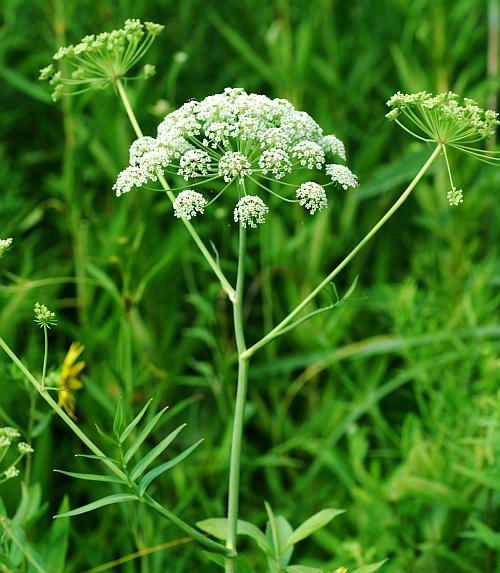Oxypolis rigidior (L.) Raf.
Cowbane

Native
CC = 7
CW = -5
MOC = 37
© SRTurner
Oxypolis rigidior (L.) Raf.Cowbane | |
 |
Native CC = 7 CW = -5 MOC = 37 |
© SRTurner |
|
Family - Apiaceae Habit - Perennial forb with clusters of tuberous-thickened roots. Stem - Ascending to erect, to 1.5 m, glabrous, often glaucous.
Leaves - Basal leaves absent at flowering. Stem leaves alternate, long- to mostly short-petiolate, or nearly sessile near top, sometimes reduced to nearly bladeless sheaths, the sheathing bases not or only slightly inflated. Blades of the main leaves 4-30 cm long, ovate to broadly triangular in outline, 1 time pinnately compound with 5-9 leaflets, the leaflets 35-150 mm long, 5-45 mm wide, lanceolate to oblong or narrowly obovate, narrowed at the base, entire or with fewer than 8 teeth per side (mostly above the middle), narrowed to a sharp point at the tip, glabrous, glaucous on the undersurface.
Inflorescence - Terminal and axillary compound umbels, short- to long-stalked. Involucre of 1-4 bracts, these 2-20 mm long, linear, sometimes with narrow, white margins, often shed by flowering. Rays 10 to numerous, 2-12 cm long. Involucel of 2-9 bractlets, these mostly shorter than the flower stalks, entire, linear.
Florets - Flowers 10 to numerous in each umbellet, the stalks 4-20 mm long. Sepals minute triangular scales. Petals ovate, narrowed or tapered to a short, slender tip, white. Petals 5, the tips often curved or curled inward. Stamens 5, the filaments free. Pistil 1 per flower, composed of 2 fused carpels, the ovary inferior with a swollen nectar disc at the tip, glabrous, the styles 2, often expanded at the base.
Fruits - Schizocarps 4-7 mm long, oblong-elliptic in outline, strongly flattened dorsally, glabrous, tan to straw-colored, with prominent, reddish brown oil tubes filling the spaces between the ribs, each mericarp with the intermediate and dorsal ribs low and blunt, the lateral ribs with broad, thin wings.
Flowering - July - September. Habitat - Bottomland prairies and depressions, streambanks, spring branches, fens, ditches, moist disturbed areas. Origin - Native to the U.S. Lookalikes - Several other members of the family, such as Sium suave, Angelica spp, Ligusticum spp., Perideridia spp., and Cicuta maculata. Other info. - This member of the hemlock family is reasonably common in the southern half of Missouri, but uncommon in counties to the north of the Missouri River. Its North American distribution is scattered throughout the eastern continental U.S. and parts of Canada. Its primary habitat is relatively good-quality fens. Photographs taken at Johnson's Shut-Ins State Park, Reynolds County, MO, 08-20-2013, St. Joe State Park, St. Francois County, MO, 10-03-2014, and Shaw Nature Reserve, Franklin County, MO, 08-03-2015 and 8-12-2020 (SRTurner). |